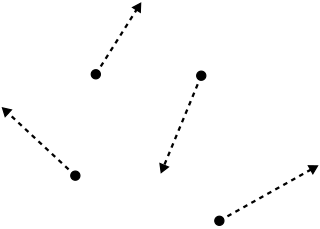
A fossil fuel is a fuel formed by natural processes, such as anaerobic decomposition of buried dead organisms, containing energy originating in ancient photosynthesis. The age of the organisms and their resulting fossil fuels is typically millions of years, and sometimes exceeds 650 million years. Fossil fuels contain high percentages of carbon and include petroleum, coal, and natural gas. Other commonly used derivatives include kerosene and propane. Fossil fuels range from volatile materials with low carbon to hydrogen ratios like methane, to liquids like petroleum, to nonvolatile materials composed of almost pure carbon, like anthracite coal. Methane can be found in hydrocarbon fields either alone, associated with oil, or in the form of methane clathrates.
An inert gas is a gas which does not undergo chemical reactions under a set of given conditions. The noble gases often do not react with many substances, and were historically referred to as the inert gases. Inert gases are used generally to avoid unwanted chemical reactions degrading a sample. These undesirable chemical reactions are often oxidation and hydrolysis reactions with the oxygen and moisture in air. The term inert gas is context-dependent because several of the noble gases can be made to react under certain conditions.
The methanol economy is a suggested future economy in which methanol and dimethyl ether replace fossil fuels as a means of energy storage, ground transportation fuel, and raw material for synthetic hydrocarbons and their products. It offers an alternative to the proposed hydrogen economy or ethanol economy.
Shielding gases are inert or semi-inert gases that are commonly used in several welding processes, most notably gas metal arc welding and gas tungsten arc welding. Their purpose is to protect the weld area from oxygen, and water vapour. Depending on the materials being welded, these atmospheric gases can reduce the quality of the weld or make the welding more difficult. Other arc welding processes use alternative methods of protecting the weld from the atmosphere as well – shielded metal arc welding, for example, uses an electrode covered in a flux that produces carbon dioxide when consumed, a semi-inert gas that is an acceptable shielding gas for welding steel.
Amine gas treating, also known as amine scrubbing, gas sweetening and acid gas removal, refers to a group of processes that use aqueous solutions of various alkylamines (commonly referred to simply as amines) to remove hydrogen sulfide (H2S) and carbon dioxide (CO2) from gases. It is a common unit process used in refineries, and is also used in petrochemical plants, natural gas processing plants and other industries.

Pressure swing adsorption (PSA) is a technology used to separate some gas species from a mixture of gases under pressure according to the species' molecular characteristics and affinity for an adsorbent material. It operates at near-ambient temperatures and differs significantly from cryogenic distillation techniques of gas separation. Specific adsorbent materials are used as a trap, preferentially adsorbing the target gas species at high pressure. The process then swings to low pressure to desorb the adsorbed material.

Carbon capture and storage (CCS) is the process of capturing waste carbon dioxide from large point sources, such as biomass or fossil fuel power plants, transporting it to a storage site, and depositing it where it will not enter the atmosphere, normally an underground geological formation. The aim is to prevent the release of large quantities of CO
2 into the atmosphere. It is a potential means of mitigating the contribution of fossil fuel emissions to global warming and ocean acidification. Although CO
2 has been injected into geological formations for several decades for various purposes, including enhanced oil recovery, the long term storage of CO
2 is a relatively new concept. 'CCS' can also be used to describe the scrubbing of CO
2 from ambient air as a climate engineering technique.
Ammonia is one of the most highly produced inorganic chemicals. There are numerous large-scale ammonia production plants worldwide, producing a total of 144 million tonnes of nitrogen in 2016. China produced 31.9% of the worldwide production, followed by Russia with 8.7%, India with 7.5%, and the United States with 7.1%. 80% or more of the ammonia produced is used for fertilizing agricultural crops. Ammonia is also used for the production of plastics, fibers, explosives, nitric acid and intermediates for dyes and pharmaceuticals.
An asphyxiant gas is a nontoxic or minimally toxic gas which reduces or displaces the normal oxygen concentration in breathing air. Breathing of oxygen-depleted air can lead to death by asphyxiation (suffocation). Because asphyxiant gases are relatively inert and odorless, their presence in high concentration may not be noticed, except in the case of carbon dioxide (hypercapnia).

Natural-gas processing is a done with process designed to clean raw natural gas by separating impurities and various non-methane hydrocarbons and fluids to produce what is known as pipeline quality dry natural gas.

A fuel is any material that can be made to react with other substances so that it releases energy as heat energy or to be used for work. The concept was originally applied solely to those materials capable of releasing chemical energy but has since also been applied to other sources of heat energy such as nuclear energy.
A bicarbonate indicator is a type of pH indicator that is sensitive enough to show a color change as the concentration of carbon dioxide gas in an aqueous solution increases. The indicator is used in photosynthesis and respiration experiments to find out whether carbon dioxide is being liberated. It is also used to test the carbon dioxide content during gaseous exchange of organisms. When the carbon dioxide content is higher than 0.04%, the initial red colour changes to yellow as the pH becomes more acidic. If the carbon dioxide content is lower than 0.04%, it changes from red to magenta and, in relatively very low carbon dioxide concentrations, to purple. Carbon dioxide, even in the concentrations found in exhaled air, will dissolve in the indicator to form carbonic acid, a weak acid, which will lower the pH and give the characteristic colour change. A colour change to purple during photosynthesis shows a reduction in the percentage of carbon dioxide and is sometimes inferred as production of oxygen, but there is not actually any direct evidence for it.
Bio-energy with carbon capture and storage (BECCS) is a potential greenhouse gas mitigation technology which produces negative carbon dioxide emissions by combining bioenergy (energy from biomass) use with geologic carbon capture and storage. The concept of BECCS is drawn from the integration of trees and crops, which extract carbon dioxide (CO2) from the atmosphere as they grow, the use of this biomass in processing industries or power plants, and the application of carbon capture and storage via CO2 injection into geological formations. There are other non-BECCS forms of carbon dioxide removal and storage that include technologies such as biochar, carbon dioxide air capture and biomass burial and enhanced weathering.
The Gas Gang were a group of short-lived fictional robots in DC Comics. They first appeared in Metal Men #6.

A helium planet is a planet with a helium-dominated atmosphere. This contrasts with ordinary gas giants such as Jupiter and Saturn, whose atmospheres consist primarily of hydrogen, with helium as a secondary component only. Helium planets might form in a variety of ways. Gliese 436 b is a candidate helium planet.
Carbon Recycling International (CRI) is an Icelandic limited liability company which has developed a technology designed to produce renewable methanol from carbon dioxide and hydrogen, using water electrolysis or, alternatively, hydrogen captured from industrial waste gases. The technology is trademarked by CRI as Emissions-to-Liquids (ETL) and the renewable methanol produced by CRI is trademarked as Vulcanol. In 2011 CRI became the first company to produce and sell liquid renewable transport fuel produced using only carbon dioxide, water and electricity from renewable sources.

Carbon-neutral fuel is energy fuel or energy systems which have no net greenhouse gas emissions or carbon footprint. One class is synthetic fuel produced from renewable, sustainable or nuclear energy used to hydrogenate carbon dioxide directly captured from the air (DAC), recycled from power plant flue exhaust gas or derived from carbonic acid in seawater. Renewable energy sources include wind turbines, solar panels, and hydroelectric power stations. Another type of renewable energy source is biofuel. Such fuels are potentially carbon-neutral because they do not result in a net increase in atmospheric greenhouse gases.
Rodney John Allam, MBE is an English chemical engineer and fellow of the Institution of Chemical Engineers who is credited with inventions related to power generation, notably the Allam power cycle, which is a generation process for fossil fuels, with integrated carbon dioxide capture.
Direct air capture (DAC) is a capture method of carbon capture and storage that separates carbon dioxide from air. While still in the early stages, proponents of direct air capture argue that it is an essential component of climate change mitigation.











